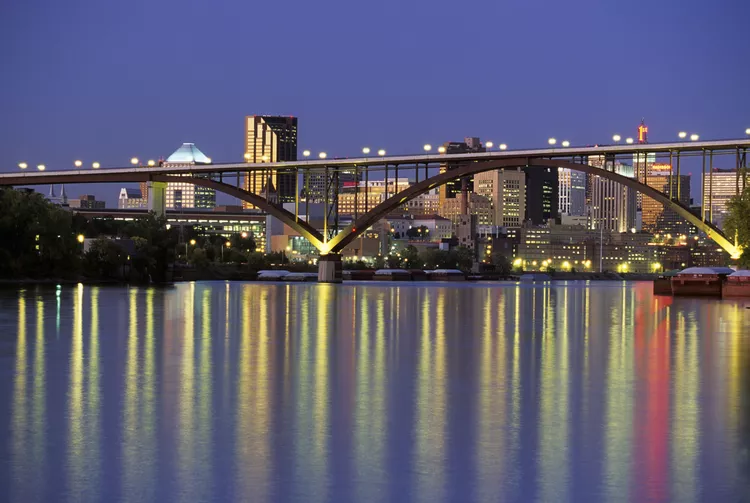Summary
In the early 1800s, a camp of squatters and traders lived near Fort Snelling on the Mississippi River, marking the first European settlement in Minnesota. The fort commander took objection to a whiskey distiller, bootlegger, and trader called Pierre Parant, forcing him out of the settlement. Parrant, nicknamed “Pig’s Eye,” eventually settled in what is now downtown St. Paul, and the settlement that grew around his tavern on the east bank of the river became known as Pig’s Eye.
This area serves as the last natural landing for steamboats traveling upriver on the Mississippi, making St. Paul an important trading site. In 1841, a Catholic chapel to Saint Paul was built on the bluffs above the landing, and the name of the settlement was officially changed to St. Paul. In 1849, the Minnesota Territory was formalized, with St. Paul designated as the capital.
Location and Borders
Downtown St. Paul is generally bounded by Interstate 94 to the north, with Kellogg Boulevard and the Mississippi River in the south. The official boundary is somewhat further north, at University Avenue. Downtown is bordered by several neighborhoods, including West Seventh, Summit-University, Thomas-Dale (Frogtown), and Dayton’s Bluff, all situated on the same side of the Mississippi. The West Side neighborhood is directly across the river from downtown St. Paul.
:max_bytes(150000):strip_icc():format(webp)/GettyImages-547788367-5c3a45dfc9e77c0001c5a95a.jpg)
Businesses and Skyscrapers
In contrast to the gleaming silver skyscrapers dominating downtown Minneapolis, downtown St. Paul features older brownstone office buildings and towers, many of which are in the art deco style. The tallest building is the Wells Fargo Place, standing at 471 feet tall. The most recognizable structure is the First National Bank Building on Fourth Street, known for its prominent red “1st” sign. Meanwhile, the Ramsey County courthouse boasts a plain exterior concealing a magnificent art deco interior, complete with a multi-story atrium clad in black marble showcasing the gigantic God of Peace Statue.
Arts, Theater, and Opera
The Ordway Center for the Performing Arts, located in Rice Park, hosts a variety of shows including theater, opera, ballet, and children’s performances. The Landmark Center features the TRACES World War II History Center, along with the Schubert Club Museum of Musical Instruments and several exhibits. Additional venues in downtown St. Paul include the Fitzgerald Theater, Park Square Theatre, and the History Theatre. A small art gallery, the Minnesota Museum of American Art, is situated on the banks of the Mississippi. Minnesota Public Radio broadcasts from their headquarters located in downtown St. Paul.
Shopping
While downtown St. Paul does not rival downtown Minneapolis as a shopping destination, it does feature a large Macy’s store and a Sears store at the edge of downtown, along with several independent shops. Notable independent retailers include the beloved Heimies Haberdashery and the art and gift store Artist Mercantile, both found in or near the pedestrian-friendly Seventh Place Mall. Additionally, the main St. Paul Farmers Market operates on Saturdays and Sundays during summer in Lowertown, with a satellite market in the Seventh Place Mall on Tuesdays and Thursdays.
:max_bytes(150000):strip_icc():format(webp)/GettyImages-185072117-5c3a498b46e0fb000177af68.jpg)
Attractions
Downtown St. Paul features several museums, including the impressive Science Museum of Minnesota and the popular Minnesota Children’s Museum. The fascinating Minnesota History Center provides insight into the state’s history and its residents. Rice Park, located opposite the Landmark Center, hosts Winter Carnival events and features sculptures of F. Scott Fitzgerald and Charles Schulz’s Peanuts characters. Another attractive park, Mears Park, offers free concerts during summer evenings. The Rivercentre is a popular venue for conventions, festivals, and music events. As the state capital, the Minnesota State Capitol is also located in downtown St. Paul.
Eating and Drinking
St. Paul boasts a small yet diverse array of restaurants. Noteworthy establishments include the iconic 24-hour Mickey’s Diner Car, the casual Key’s Cafe, the refined Meritage, and the upscale St. Paul Grill. Additionally, international cuisine options abound, featuring restaurants like Fuji-Ya, Pazzaluna, Senor Wong, and Ruam Mit Thai Cafe, which is often regarded as the best Thai restaurant in the Twin Cities.
Sports and Nightlife
The Xcel Energy Center stands as the primary sporting venue in downtown St. Paul, well-known in the ice hockey community. Besides sporting events, the Xcel Energy Center also hosts conferences and music concerts. Visitors to the Xcel often enjoy a drink at one of the nearby bars on West Seventh Street, such as the Liffey, a popular Irish pub. Furthermore, downtown St. Paul features a handful of nightlife venues like Great Waters Brewing Company, Alary’s Bar, and Wild Tymes Sports Bar & Grill.
Living
Homes in downtown St. Paul encompass apartments, studios, lofts, and condos. The downtown area features several new high-rise condo developments alongside older warehouses transformed into modern living spaces. Apartments integrated within the skyway system command higher rental prices. The cost of parking can significantly increase overall living expenses.
Transportation
- Walking: The simplest method to navigate downtown is often by foot. The area is quite compact, and the skyway system connects most major buildings and attractions.
- Driving: Parking ramps are available, but they tend to be pricey. Most street parking is metered, and having a rechargeable parking card is beneficial for frequent meter users. Meters are complimentary in the evenings and on Sundays.
- Bus and train: Downtown St. Paul is highly accessible via public transportation. Numerous bus routes service the downtown area. The METRO Green Light Rail connects Downtown St. Paul to Downtown Minneapolis.




